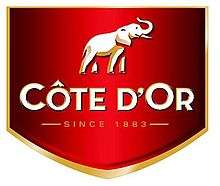Côte d'Or (chocolate)
 | |
 A box and partially opened bar of Côte d'Or milk chocolate | |
| Product type | Confectionery |
|---|---|
| Owner | Mondelēz International |
| Country | Belgium |
| Introduced | 1883 |
| Markets | Worldwide |
| Website |
www |
Côte d'Or is a producer of Belgian chocolate, owned by Mondelēz International. Côte d'Or was founded in 1883 by Charles Neuhaus,[1] a chocolate manufacturer who used the name Côte d'Or (French for Gold Coast) referring to the old name of contemporary Ghana, the source of many of the cacao beans used in chocolate manufacturing.
Côte d'Or was purchased by Jacobs Suchard in 1987; Jacobs Suchard in turn was purchased by Kraft General Foods in 1990, which forked off its chocolate and confectionery brands into Mondelez International in 2012, so that Mondelez is the current owner of the Côte d'Or brand.
Belgians consume 600 million Côte d'Or products a year.[2] Every day, the Côte d'Or factory in Halle (near Brussels) used to produce 1.3 million mignonnettes (small chocolate bars) (they are now produced in Poland), and 2 million Chokotoffs (chocolate bonbons).[2]
History

Logo
The emblem of Côte d'Or is an elephant, a symbol which recalls the African origin of the cocoa beans used in the manufacture of Côte d'Or. One source also claims that elephants were used to haul the sacks of cocoa beans. In an earlier version of the logo three pyramids and a palm tree were also featured. This logo was based on a Ghanaian post stamp, showing three icons (elephant, palm tree, pyramids) of exotic Africa.
Notable events
During World War II, high quality ingredients became unavailable. In addition, one of their factories in Marseilles, France was destroyed during the German destruction of the Vieux Port district in early 1943. Because of this, Côte d’Or stopped producing chocolate, making room for the lower quality Congobar.[3]
Ethical cocoa sourcing
There have been continuing question marks over the ethical stance of chocolate brands worldwide. After it became public in 2001 that thousands of children were being trafficked and exploited on the cocoa farms of the Ivory Coast,[4][5][6] Kraft, along with the rest of industry, signed the Harkin-Engel Protocol,[7] promising to remove the worst forms of child labour from the cocoa supply chain.
In October 2009 Kraft has launched the first mainstream chocolate products in Europe to carry the Rainforest Alliance Certified seal. Starting in France and Belgium, this Côte d'Or premium dark chocolate contains at least 30 percent cocoa from Rainforest Alliance Certified farms. Kraft declared they would roll out the certified Côte d'Or range to consumers in the United Kingdom, Germany, Spain, Hungary, Poland, Portugal, the Netherlands, Canada and the United States. Kraft Foods also planned to use cocoa beans from Rainforest Alliance Certified farms only across its entire Côte d'Or and Marabou lines, representing some 30,000 tonnes of beans, by the end of 2012.[8]
Availability by country
Currently Côte d’Or is sold in more than 40 countries, across 5 continents.
| North America and Caribbean | Asia | Europe | Africa | Oceania | South America |
|---|---|---|---|---|---|
Product examples
Milk Chocolate 100g - Pure Côte d'Or Milk Chocolate
Dark Chocolate 100g - 54% dark chocolate decadence
Milk Chocolate 47 g - Smooth Milk Chocolate in an on-the-go small bar
Dark Chocolate 47 g - Dark Chocolate in an on-the-go small bar
Lait intense - Creamy milk chocolate around a dark chocolate center to create a decadent, intense taste.
86% Noir Brut - Côte d’Or Brut contains 86 percent cocoa for a smooth, pure and intensely rewarding experience.
Noir Orange - A rewarding deep, dark chocolate complemented by orange chocolate-truffle and pieces of candied orange zest.
Noir 70% cacao - Intense 70% Cacao has outside layers of dark chocolate that surround a rich center and delivers a rich dark chocolate taste.
Noir 70% cacao with caramelized cocoa nibs - Intense 70% Cacao has outside layers of dark chocolate that combined with the crunchy texture of caramelized cocoa nibs.
Noir de Noir Mignonnettes - 10-gram squares with 56 percent cocoa used for sophisticated sampling.
Lait Intense Mignonnettes - Bite-size morsels of sweet milk chocolate with a thin layer of rich, intense chocolate hidden within.
Milk Chocolate with Hazelnuts 45g - Smooth milk chocolate with chopped hazelnuts.
Milk Chocolate 150g (2x 75) - Milk Chocolate featured in Centennial paper wrap packaging from 1911
Dark Chocolate 150g (2x 75) - Dark Chocolate featured in Centennial paper wrap packaging from 1911
Chokotoff - Famous caramel-chocolate toffee
Les Bouchées - Available in milk, white, hazelnut or truffle, these are made in the shapes of elephants (though most people think they are mice). The chocolate elephant shells are filled with a ganache of chocolate, sometimes with hazelnuts.
References
- ↑ "Côte d`Or - Home". Cotedorus.com. Retrieved 2009-07-25.
- 1 2 "Côte d`Or - wist_u_dat". Cotedor.be. Retrieved 2009-07-25.
- ↑ Cote-d'or
- ↑ Humphrey Hawksley (12 April 2001). "Mali's children in chocolate slavery". BBC News. Retrieved 2 January 2010.
- ↑ Humphrey Hawksley (4 May 2001). "Ivory Coast accuses chocolate companies". BBC News. Retrieved 4 August 2010.
- ↑ Sudarsan Raghavan and Sumana Chatterjee (24 June 2001). "Slaves feed world's taste for chocolate: Captives common in cocoa farms of Africa". Milwaukee Journal Sentinel. Archived from the original on 17 September 2006. Retrieved 25 April 2012.
- ↑ "Protocol for the growing and processing of cocoa beans and their derivative products in a manner that complies with ILO Convention 182 concerning the prohibition and immediate action for the elimination of the worst forms of child labor" (PDF). International Cocoa Initiative. 2001. Archived from the original (PDF) on 24 July 2008. Retrieved 25 April 2012.
- ↑ Major European Kraft Chocolate Brands Embrace Rainforest Alliance Certification | Rainforest Alliance
External links
| Wikimedia Commons has media related to Côte d'Or (brand). |